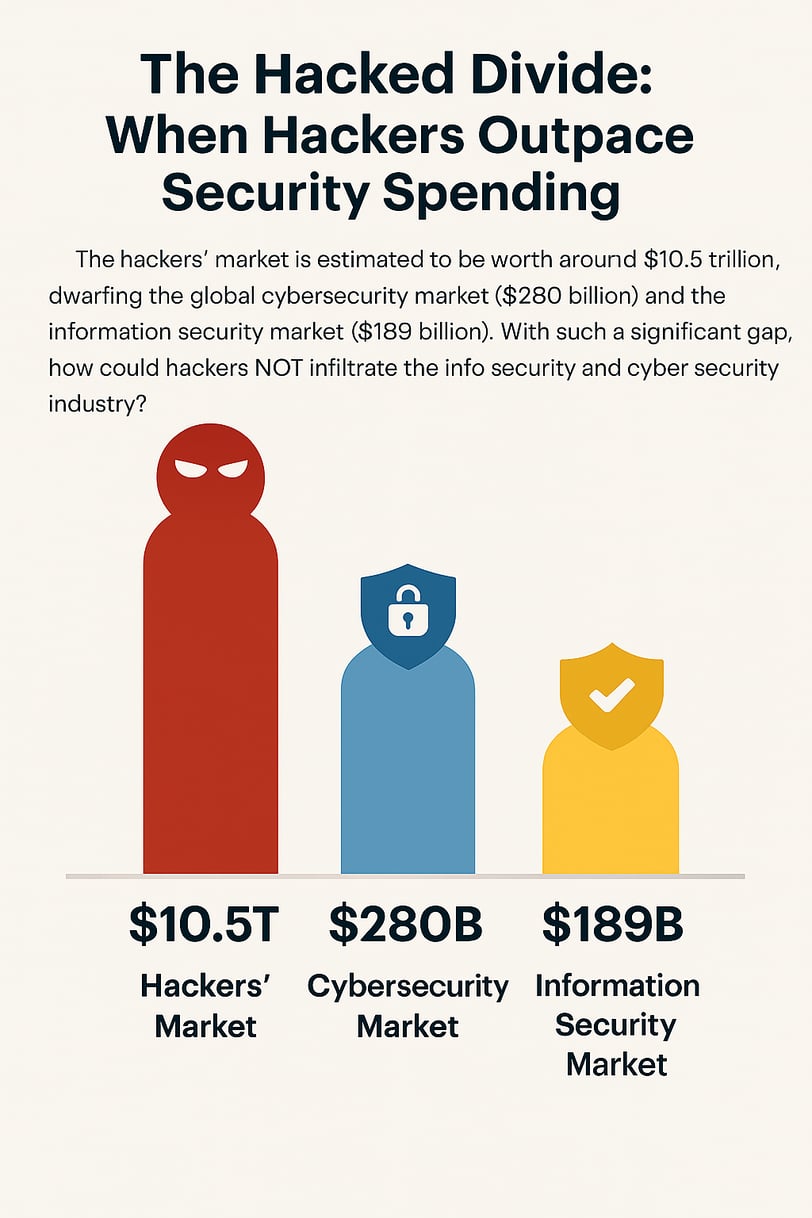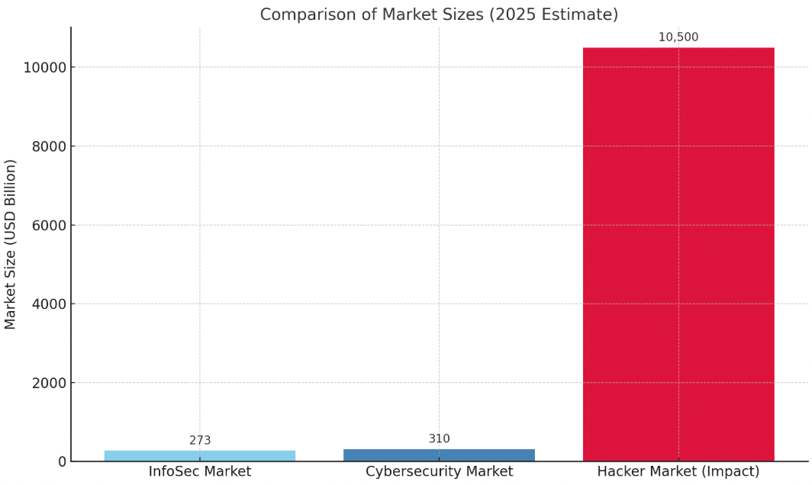The Invisible War: When Hackers Outpace the Cybersecurity Industry
If the hacker economy were a country, it would be the third largest economy on Earth — just behind the U.S. and China.
CISOHACKERSMARKET
Roshan Yacob George C|CISO CISSP CISA CFE
5/19/20253 min read


Imagine a world where the "bad guys" aren't just keeping pace with the good guys — they're outpacing them, infiltrating their camps, wearing the same uniforms, and even getting a seat at the strategy table. That world isn't fictional anymore. It's our reality.
The Market Gap No One Is Talking About. In 2025, the global cybersecurity market is valued at approximately $310 billion. The broader information security market trails close behind at $273 billion. Meanwhile, the hacker economy — comprising cybercriminals, ransomware syndicates, state-sponsored attackers, and underground markets — is worth a staggering $10.5 trillion.
This isn't just a gap. It's a gaping chasm. And the implications are terrifying.
Infiltration: The Trojan Horse Within Our Ranks
The security industry once prided itself on rigorous certifications like CISSP, CISA, and CISM. These were badges of honor, proof of hard-earned expertise. But today, certified professionals are increasingly being sidelined for self-proclaimed experts — many of whom lack formal credentials, and some who may even be acting as plants from the hacker economy.
The rapid demand for cyber talent has led to a loosening of entry barriers. Many organizations now prioritize "hands-on experience" over verified certifications. While experience is crucial, this shift opens the door for actors from the dark web who pose as saviors, only to exploit from within.
Visual: Infiltration Funnel
Top: Hacker Market ($10.5T)
Funnel: Self-proclaimed cybersecurity experts without certification
Bottom: Entry into CISO/InfoSec/CyberSec roles
The Danger of Normalizing the Unvetted
Risk 1: Dilution of the profession and its credibility
Risk 2: Compromised national and corporate security
Risk 3: Erosion of trust among clients, consumers, and stakeholders
A Call to Action: Secure the Gates Before It's Too Late We must:
Re-emphasize the importance of globally recognized certifications
Build vetting protocols for security hires
Create industry-wide watchlists to flag and investigate anomalous entrants
When the fox is not just in the henhouse, but helping run the security cameras, it's not just time to upgrade the locks. It's time to burn down the illusion of safety we've built and start anew.
Because if we don't defend the defenders now, there may be no one left to defend us later.
In today’s hyperconnected world, cybersecurity is not just a technical concern—it’s a trillion-dollar battleground. Organizations are investing billions to protect their digital assets, while cybercriminals continue to evolve and expand their illicit operations. To understand the scale and complexity of this digital arms race, let’s compare the three major players in this ecosystem:
The Information Security Market
The Cybersecurity Market
The Hacker (Cybercrime) Market
1. The Information Security Market
Size: Estimated to reach $273 billion by 2028, growing at a CAGR of 12.8% from 2023 onwards.
Scope: Encompasses governance, risk, and compliance (GRC), security policies, training, audits, and strategic controls.
Information security (InfoSec) is the broader umbrella under which cybersecurity falls. It focuses not just on digital information, but also on physical and organizational measures to protect the confidentiality, integrity, and availability (CIA) of data. Think of it as the “why” behind security—setting the rules and frameworks that govern data protection.
Key components:
Risk assessments
Policy creation
Compliance (ISO 27001, NIST, PCI DSS)
Security awareness training
Internal audits
2. The Cybersecurity Market
Size: Estimated to exceed $310 billion by 2027, with aggressive growth due to digital transformation and cloud migration.
Scope: Focuses on technical measures to protect digital assets—networks, systems, and data—from cyber threats.
Cybersecurity is the execution arm of information security. It uses tools, platforms, and technologies to prevent, detect, and respond to cyberattacks. With a rise in ransomware, phishing, and APTs (Advanced Persistent Threats), companies are investing heavily in cybersecurity infrastructure.
Key components:
Firewalls, IDS/IPS
Endpoint Detection and Response (EDR)
Cloud and network security
Threat intelligence
Vulnerability management
Security Operations Centers (SOCs)
3. The Hacker (Cybercrime) Market
Size: Projected to cost the global economy $10.5 trillion annually by 2025, according to Cybersecurity Ventures. If measured by GDP, cybercrime would rank as the 3rd largest economy in the world—only behind the U.S. and China.
This “dark market” includes ransomware gangs, data thieves, phishing scammers, and nation-state actors. It thrives on weaknesses in digital infrastructure, underinvestment in security, and widespread use of commoditized hacking tools.
Revenue streams include:
Ransomware payouts
Stolen data sales on the dark web
Cryptojacking
Phishing and Business Email Compromise (BEC)
Cybercrime-as-a-Service (CaaS)
Criminal groups are increasingly organized, leveraging RaaS (Ransomware-as-a-Service) and sophisticated evasion tactics, sometimes even outperforming legitimate tech vendors in speed and innovation.
Sources:
Cybersecurity Market Size:
Statista – “Cybersecurity market revenue worldwide from 2016 to 2028”
https://www.statista.com/statistics/595182/worldwide-security-as-a-service-revenue/
Information Security Market Size:
MarketsandMarkets – “Information Security Market by Component, Solution, Services, Deployment Mode, Organization Size, Vertical, and Region - Global Forecast to 2027”
https://www.marketsandmarkets.com/Market-Reports/information-security-market-1168.html
Hacker Economy Valuation ($10.5 Trillion):
Cybersecurity Ventures – “Cybercrime To Cost The World $10.5 Trillion Annually By 2025”
https://cybersecurityventures.com/cybercrime-damages-6-trillion-by-2021/
Credentialed vs. Self-Proclaimed Experts:
ISACA – “The Importance of Cybersecurity Certifications”
https://www.isaca.org/resources/news-and-trends/newsletters/atisaca/2020/volume-23/why-certifications-matter-in-cybersecurity
Hiring Trends and Talent Shortage:
(ISC)² Cybersecurity Workforce Study 2023
https://www.isc2.org/Research/Workforce-Study
Infiltration Risks and Insider Threats:
IBM X-Force Threat Intelligence Index 2024
https://www.ibm.com/reports/threat-intelligence


